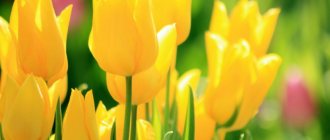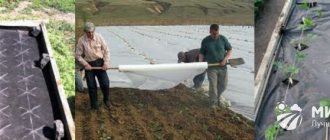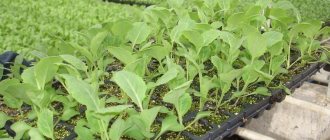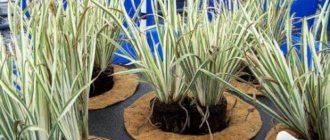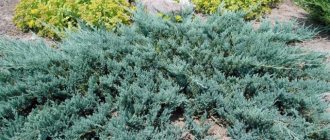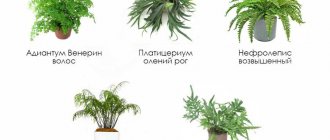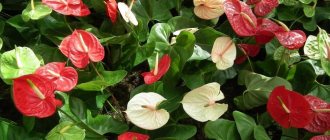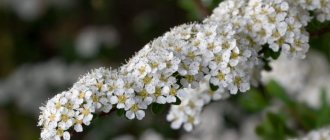Tuevik drooping: description of the variety and variety
Drooping arborvita: video thujopsis dolabrata
The drooping arborvitae is considered Japanese; there is only one such variety that is included in the cypress genus along with other spruce trees or shrubs. Place of birth - Japan, arborvitae grows drooping in the mountains at altitudes of about two thousand meters. Such a plant can grow for more than a thousand years. For example, the Japanese nicknamed this tree “Hiba”; they plant it next to the church, in parks, greenhouses and other places.
In most cases, the thuevik is small in stature, about ten or fifteen meters with widely spread branches. In Russian regions, a plant cannot have such large parameters, only in the form of a bush of about one and a half or two meters, it will grow to such a size in thirty years, since its maturation is very long.
The branches of the plant grow in two rows along one line. The first thing that happens is that the buds turn green, then khaki, then brown, overgrown with needles. The tree trunk is brownish colored.
The needles of the drooping thuevik are in the form of scales, looking up. The color is darkish, shiny, closer to the light-colored shoots, this is the highlight of the plant.
As mentioned above, the needles grow along a line in several rows. If you touch the plant, you can get a smell like a pine forest. In winter, in the regions of Russia, the needles change color, becoming reddish and brown. All plants must have inflorescences, “Khiba” has cones, in appearance we can say that they look like an oval, up to one and a half centimeters in size. By their structure we can say that a large accumulation of scales is attached to each other, their color is gray-green, after their ripening the color changes to brown, more woody. The grains are flat, oval in shape with a pair of wings, measuring about seven millimeters.
In appearance, the drooping thuevik looks aesthetically pleasing, has an unusual shape, and can be used for site decoration.
For example, the drooping thujopsis Nana (thujopsis dolabrata nana) is relevant in the Western Russian regions. And the plants “Thuevik drooping Variegata” and “Aurea” are used in common cultivation with other plants.
In the southern regions, it is common as a shady space; it can be grown alone or with any other cultivated crops.
Conifers are of great importance in nature and economy. Suffice it to say that forests with their predominance make up almost half of the forests on our planet, and in Russia even more - two-thirds. In addition to the biosphere and resource function of conifers, their aesthetic function is no less important. Throughout the northern hemisphere, with the exception of tropical latitudes, conifers are an essential component of the cultural landscape. In the West and Far East they are represented not only by dozens of wild species, but also by hundreds (perhaps even thousands!) of varieties, cultivars, and garden forms. Their enormous diversity is ensured by technologies of reproduction, cultivation, and use. What does Russia look like against this background? Alas, it's not very bright yet. On the one hand, this is understandable: in many other respects we lag behind developed countries. On the other hand, this is unacceptable. After all, Russia is a northern territory with harsh climatic conditions, where the need for the widest use of coniferous plants to decorate our lives is predetermined by nature itself.
The natural conditions of our country do not allow us to simply take and transfer numerous foreign species and varieties to us. They need to be tested, verified, analyzed; only after that - apply. At the same time, we need to generalize our own experience; to study and use, including for selection, the enormous potential of Russian coniferous species that are absolutely resistant to our climate. No one will do this most important work for us, neither in Europe, nor in America, nor in China. Only we can do it ourselves!
In countries with a developed horticultural culture, its obligatory component is the so-called “conifer societies” - public organizations of professionals and advanced amateurs who specifically deal with the whole range of issues relating to this group of garden plants. Since October 18, 2008, we have such an organization, the Russian Society for Selection and Introduction of Conifers (Russian Conifer Society)! You are on her website.
The goal of the Society is to promote the introduction and selection of conifers, especially rare and unusual ones, used for garden culture and landscape construction.
This goal is specified and detailed in our tasks. Most of the Society's information and communication activities are carried out through this website. Therefore, in order to imagine this system and successfully integrate into it, you need to become familiar with the structure of the Company and the structure of its website. READ MORE…
Garden energy
Drooping arborvita "Variegata" (Thujopsis dolabrata "Variegata") is a slow-growing variety with a wide cone shape. The shoots are wide, flat, green with characteristic creamy-white fragments. Needs fertile and moist soils, in a place protected from the wind. Recommended for home gardens as a solitary plant.
Crown shape and height: up to 30 m. By 10 years it reaches a height of 0.8 m. The crown is ovoid.
Needles: scale-like, shiny, dark green with yellow stripes.
Light: prefers partial shade or shade, is demanding on air humidity and soil fertility.
Root system : in adult plants it is powerful and branched.
Watering: Moderate regular watering is required for good development. It is very drought tolerant in the shade and needs watering only during the period of active growth. In open areas requires deep watering. It is demanding on air humidity, it is recommended to water the crown once a week
Soil: Prefers fertile, well-drained, moist soil.
Planting: Preservation of the root ball is required. A slight deepening of the root collar is acceptable. In open areas it is susceptible to spring burns. Indispensable for shady gardens; in the sun the needles lose their richness in color. Suitable for winter gardens with temperatures no higher than +15 degrees, where it can grow in the ground or in a spacious container
Care: prefers fertile loams; on poor soils, in early spring they are fed with special fertilizers for coniferous plants. At a young age, it requires mulching the root system and covering it with spruce branches for the winter.
Pruning: Does not require pruning, but formative pruning can be done throughout the summer. When the top is trimmed, it forms a beautiful tiered-horizontal crown. It is not suitable for creating trimmed forms, but to give the shape of a bush, individual branches can be cut in summer
Reproduction methods: seeds, green cuttings, lignified cuttings, layering, grafting
Peculiarities of seed propagation: use fresh seeds, as they lose their viability throughout the year. Seeds are subjected to 3-4 months of cold stratification. Germinate at a temperature of +18+23 degrees in the light, but not in direct sunlight. Planted in the ground in the spring after preliminary hardening
Vegetative propagation: easily propagated by cuttings, especially from young plants. Cuttings are cut from short lateral branches: in the spring - from last year's growths, in the summer - from current hardened growths. Cuttings are rooted in greenhouses at high air humidity, moderate substrate humidity and a temperature of +15+18 degrees until the buds awaken, which is then raised to +20+23 degrees. The use of rooting stimulants has a positive effect. When propagated by horizontal layering, the pyramidal shape of the crown is not preserved; the result is more spreading. It is grafted onto thuja occidentalis, but the grafted plants are inferior in life expectancy
Acidity: pH 5-7 - acidophilus plant (calcephobe) - loving acidic soil.
Climate zone: 6a. In the conditions of the Moscow region, it can freeze in open places, so it is recommended to plant it in a warm, protected place where the thuevik overwinters well.
Use in landscape design: compositions near ponds, among stones, in rock gardens, flower beds, when creating coniferous mixborders, as well as when growing in containers. In addition, thanks to the substances released into the surrounding space, phytoncides, coniferous plants cleanse the air of pathogens.
Tuevik drooping Variegata
International name: Thujopsis dolabrata Variegata
Height: By the age of 10, it can grow up to 80 cm in height with a width of up to 60 cm. Maximum height is 1.2 meters.
Width: Crown diameter up to 1.0 meters.
Needles: The branches are wide and flat, the needles are scaly, tightly pressed to the shoot, shiny green above, with large white spots below.
Growth Rate: Slow
Illumination: partial shade, shade
Frost resistance: 6a - down to -23.3 °C (-10 °F)
Soil: Prefers fertile, moist, humus-rich soils, with the exception of sandy soils and a wide range of acidity, from acidic to alkaline.
History: The specific name “Japanese” is associated with its place of natural growth. It grows in central Japan in dense and humid mountain forests, occupying altitudes from 500 to 3000 m above sea level. Its companions are evergreen oaks, magnolias and a variety of conifers.
Lifespan: The arborvitae can live more than 500 years.
Important!!!: When rubbed, the scales emit a pleasant “pine” aroma.
Thuja drooping - also known as Japanese or chisel-shaped, the only species in its botanical genus, belonging, together with thuja and juniper, to the Cypress family.
Its homeland is Japan, where it grows in humid mountain forests at altitudes of up to 2000 m. This is a very durable tree and a thousand years there is not the limit for it. In Japan, chisel thuevik is called “hiba” and is planted near temples, in parks and gardens. The tree there is up to 15 m high.
Variegata (Thujopsis dolabrata Variegata) is a slow-growing variety with a wide-rounded crown, close to the original species, up to 1.2 meters in the middle zone, crown diameter up to 1.0 meters. By the age of 10, it is able to grow in height only up to 80 cm with a width of up to 60 cm.
Prefers fertile, moist, humus-rich soils, with the exception of sandy ones, and a wide range of acidity, from acidic to alkaline.
The needles are white-variegated. The branches are wide and flat, the needles are scaly, tightly pressed to the shoot, shiny green above, with large white spots below. At first the shoots are green, olive-green, later reddish, densely covered with needles. The bark of the branches and trunks is reddish-brown, scaly and flaky.
When rubbed, the scales emit a pleasant “pine” aroma.
In our conditions, in winter the ends of the plant’s branches turn slightly brown. The cones of the thuja are much larger than those of the thuja, rounded, up to 1.5 cm . They consist of pointed greyish-green fleshy scales, which become woody and brown as they mature, and mature in the first year. The seeds are oblong-round, flattened, with two wings, up to 7 mm long and wide.
Variegata drooping arborvitae is susceptible to spring burns in open areas. Demanding on air humidity. It tolerates cutting and shaping well. Winter hardiness is low. Classified as USDA Zone 6 . In the conditions of the middle zone, it may freeze in open places, so it is recommended to plant in a warm place protected from the winds.
Tuevik in landscape design:
- Trees and shrubs have a very interesting crown shape, so they look beautiful in single plantings.
- Their needles have a decorative appeal.
- Both adult and young plants look aesthetically pleasing.
- In group plantings they are planted together with other coniferous plants:
- cypress trees,
- thuja,
- pine trees,
- fir trees and
- juniper.
- Used to create gardens with stones or rocky landscapes.
- Tuevik grows well in containers that can be used on open terraces.
- Used to create alleys.
- You can often see thuevik in rock gardens and rockeries.
- Indispensable for shady gardens; in the sun the needles lose their richness in color.
Location
Tuevik develops well in partial shade , and can also grow in sunlit places. Requires protection from drafts and cold winds. It is recommended to plant seedlings in spring. The minimum distance between plants must be at least 50 cm. The depth of the planting hole is 60 cm. Replanting is carried out using the transshipment method so as not to damage the root system. When planting, add nitroammophoska (250 g), which is thoroughly mixed with the soil. The plants tolerate replanting well, which is best done in the spring; the root collar is not buried.
The soil
Trees prefer moist loams, there are requirements for fertility (preferably medium-fertile soil). Good drainage with a thickness of 10-15 cm is required. Recommended soil mixture: garden soil, sand and peat compost (2:2:3). The same composition is used when growing in containers.
Watering
Tuevik is drought-resistant. In hot weather, it is necessary to sprinkle (spray) in the evening; plants prefer high air humidity. Water regularly at the top 5 cm of soil.
Care
Fertilize annually with complex fertilizer such as “Kemira Universal”. Fertilizing is done in early spring. Once every three years, in late autumn, the tree trunk circles are carefully dug up. Young seedlings are mulched with a layer of peat or sawdust (up to 7-10 cm). In winter, the thickness is increased to 15 cm, and the plant itself is covered with spruce branches. Adult specimens are frost-resistant and do not require protective equipment.
Trimming
Tuevik grows very slowly. Formative pruning is carried out only when necessary. In spring, dry branches must be cut out.
Diseases and pests
The needles of the thuevik are affected by spider mites, as a result of which they turn yellow and fall off. The scale insect has the same destructive effect. Suitable insecticides are used to protect plants. With poor drainage and too much watering, the roots of the thuevik can be affected by root rot. At an early stage of disease development, the plant must be replanted and the affected parts of the roots removed. In the worst case scenario, the tree dies.
0
https://gardentoday.ru/%d1%82%d1%83%d0%b5%d0%b2%d0%b8%d0%ba-%d0%bf%d0%be%d0%bd%d0%b8% d0%ba%d0%b0%d1%8e%d1%89%d0%b8%d0%b9-%d0%b2%d0%b0%d1%80%d0%b8%d0%b5%d0%b3%d0 %b0%d1%82%d0%b0/
Author of the publication
offline 4 days
Adminka
28
Comments: 1Publications: 384Registration: 10/24/2020


